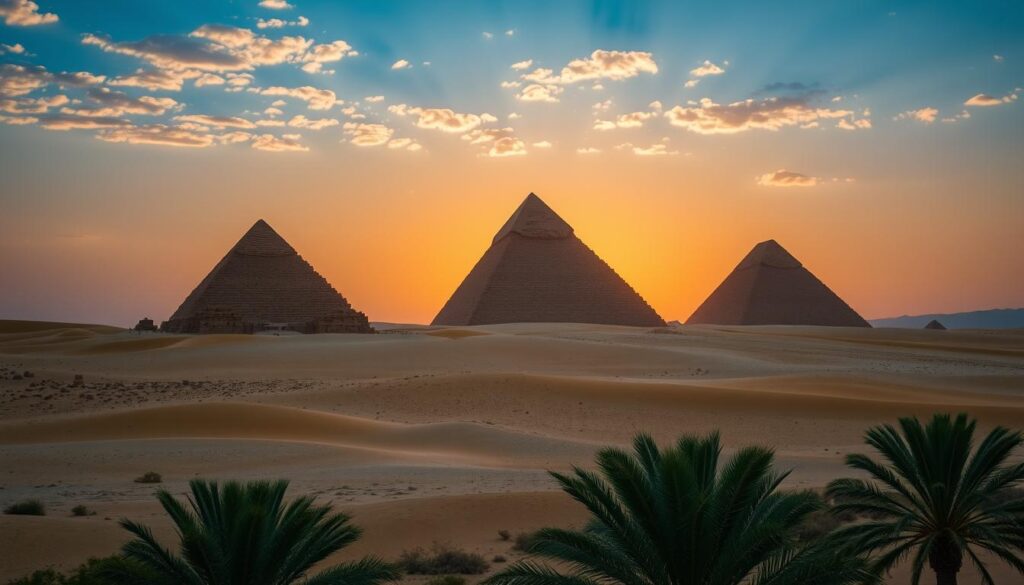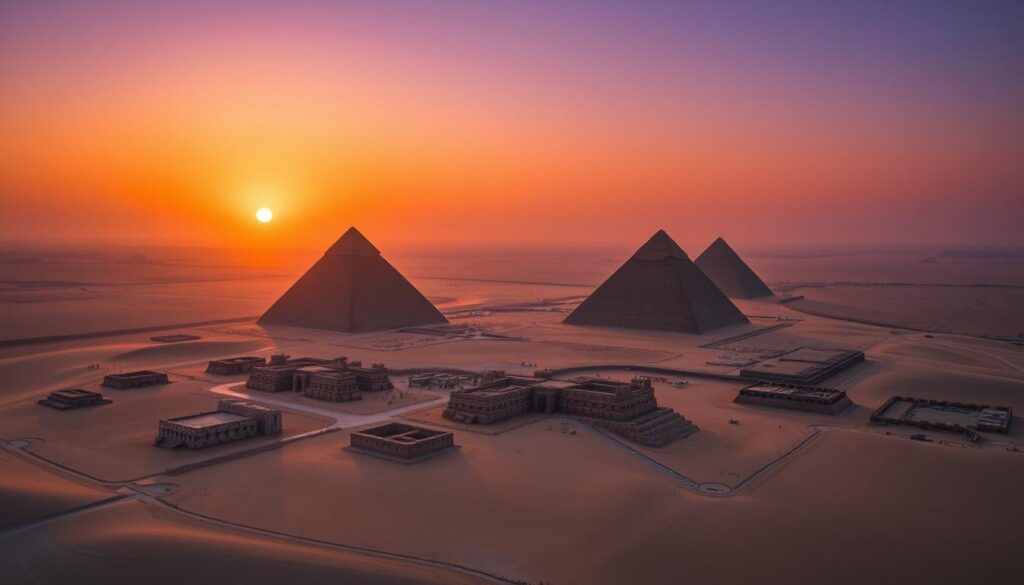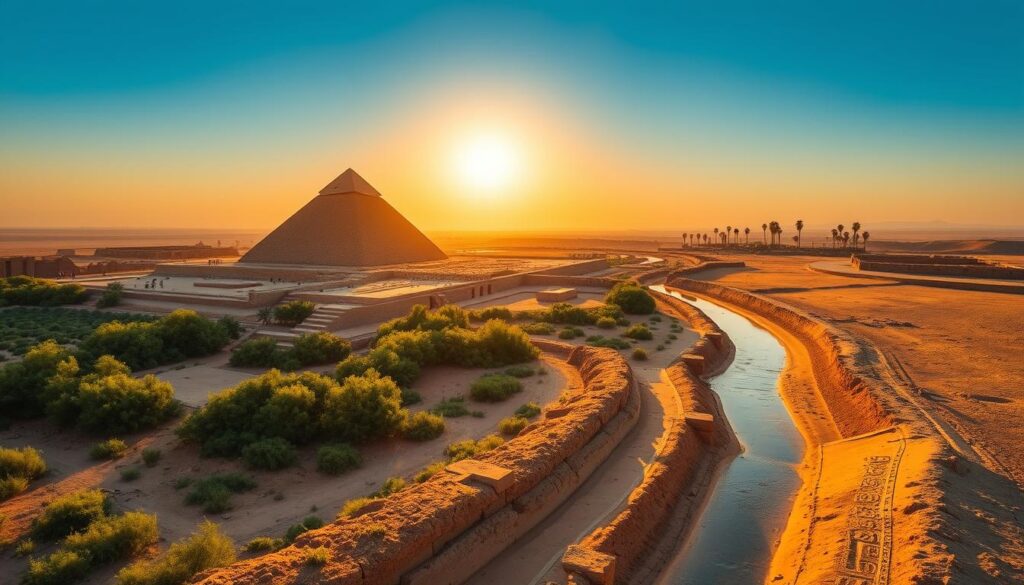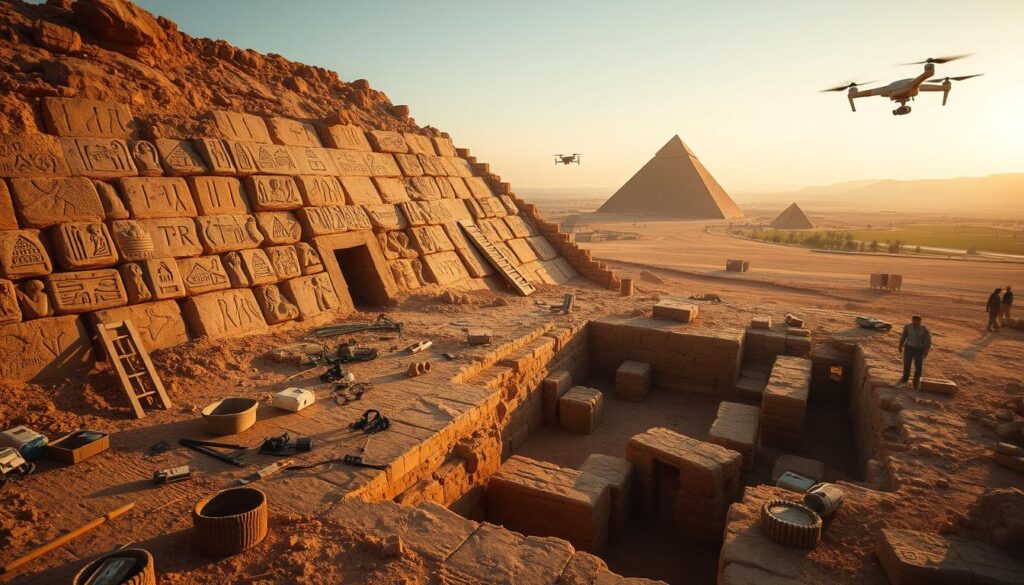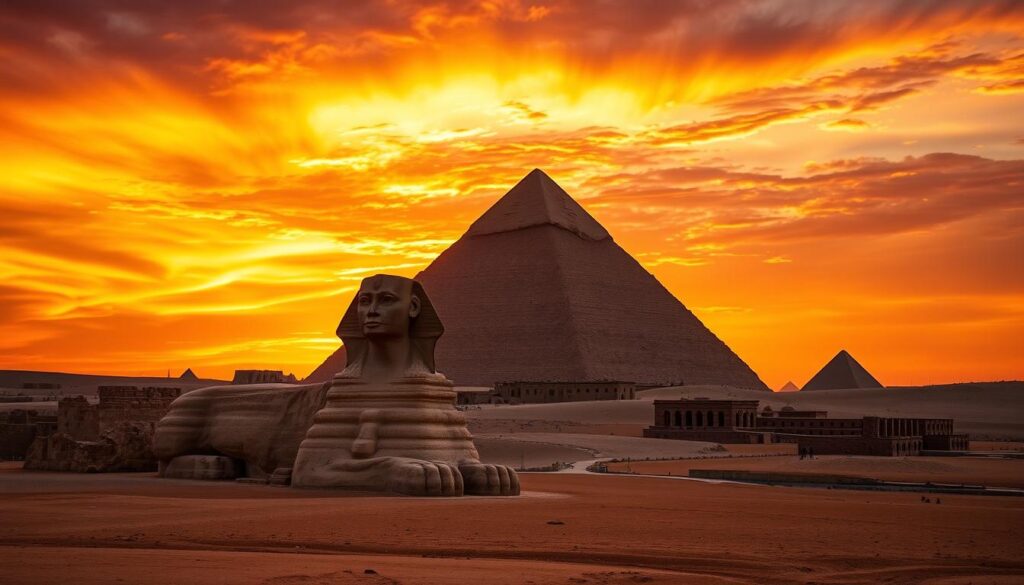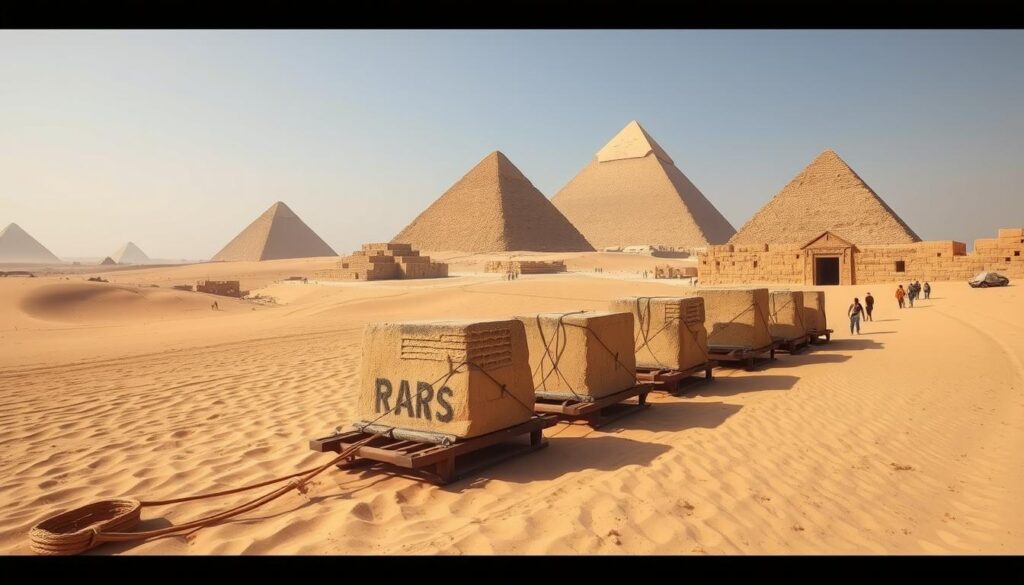The pyramids of Egypt stand tall against the desert, captivating us for thousands of years. Their construction shows the ancient Egyptians’ ingenuity and hard work. Each pyramid, from Giza to the Saharan expanse, holds secrets of the past, waiting for us to discover.
Despite much study, many questions remain about these ancient marvels. New research has uncovered how the Nile River influenced their building. This has shed light on their strategic placement.
Key Takeaways
- The ancient Egyptians built over 31 pyramids, including the iconic Giza complex, more than 4,000 years ago.
- A newly discovered ancient waterway, the Ahramat branch, ran for 64 km (39 miles) and bordered 31 pyramids built between 4,700 and 3,700 years ago.
- The proximity of the Ahramat branch to the pyramids suggests it was operational during their construction, allowing the Egyptians to utilize the river’s energy for transportation rather than relying solely on human labor.
- The discovery of the Ahramat branch explains the high density of pyramids between Giza and Lisht in the Saharan desert, as the river provided a strategic location for these architectural wonders.
- Ongoing archaeological research, including the use of advanced technologies, continues to uncover new insights into the construction and purpose of these ancient Egyptian masterpieces.
The Magnificence of Egyptian Pyramid Architecture
The Egyptian pyramids are huge symbols of ancient architectural skill. They were built over many generations, with each group adding to the design and building methods. The Giza Necropolis is home to the famous Great Pyramid, a top example of ancient architecture and engineering.
Evolution of Pyramid Design Through Dynasties
The first pyramids, like Djoser’s Step Pyramid, were small and simple. But as time went on, the pyramids got bigger and more complex. The Great Pyramid of Giza, built around 2560 BC for Pharaoh Khufu, is an amazing 148 meters tall. It was the tallest man-made structure for over 3,800 years.
Architectural Significance in the Ancient World
The ancient Egyptian pyramids are known for their precision and math skills. The Great Pyramid, for example, has sides that are almost perfectly aligned with the compass directions. Its design also shows a deep understanding of math, with a ratio that closely matches 2π.
Materials and Construction Techniques
The pyramids were made from huge limestone blocks, some weighing tons. New research shows that ancient Egyptians might have used waterways to move these heavy stones. The Great Pyramid alone needed about 800 tons of stone moved every day for 20 years. This means around 2.3 million stone blocks were moved and placed.
“The research uncovered the existence of an ancient waterway named Ahramat connecting 31 pyramid tombs in Egypt to the Nile. The waterway is thought to have been in use during the 1,000-year period of pyramid construction, starting approximately 4,700 years ago in the Old Kingdom era.”
The Discovery of the Ancient Ahramat Waterway
An international team has found the ancient Ahramat waterway. It once flowed by over 30 pyramids in Egypt, including the famous Giza pyramid complex. This find, using radar, maps, surveys, and coring, shows how the ancient Egyptians moved materials to build these wonders.
Satellite Imagery and Archaeological Evidence
The Ahramat branch was about 64km long and 200-700m wide. It was near pyramids built from 4,700 to 3,700 years ago. Eman Ghoneim’s study shows it was active until around 2200 B.C., helping move materials and workers.
Connection to the Nile River System
The Ahramat branch was as big as the Nile, allowing boats to travel both ways near the pyramids. It started to silt up and move east around 2000 B.C. This change might have affected where pyramids were built during Egypt’s Middle Kingdom.
Impact on Pyramid Construction Theory
This find sheds new light on moving massive stone blocks for pyramids. The river likely helped float these heavy materials from the south. More research, like dating sediments, will reveal more about the Ahramat branch’s role in pyramid building.
“This remarkable discovery of the ancient Ahramat waterway has the potential to revolutionize our understanding of how the ancient Egyptians constructed their magnificent pyramids.”
Uncovering the Ancient Pyramids of Egypt: Modern Archaeological Breakthroughs
The ancient Egyptian pyramids have always fascinated many. In recent years, new methods have changed how we see these wonders. Archaeological Wonders and Egyptology Breakthroughs have uncovered secrets about the pyramids.
New tools like ground-penetrating radar and electrical resistivity tomography have been key. They let researchers look under the sand without digging. This has found hidden structures and secrets that were unknown before.
“These modern techniques have opened up entirely new avenues of research, allowing us to uncover secrets that have eluded us for centuries,” says Dr. Sarah Khalil, a renowned Egyptologist at the University of Cairo.
For instance, a study used satellite images and old maps to find a lost Nile branch. This branch, called the Ahramat Branch, was near the pyramids. It showed how the ancient Nile might have helped build the pyramids.
Ground-penetrating radar and electrical resistivity tomography also found new underground structures at Giza. This has made people wonder even more about the ancient Egyptians’ skills. These discoveries have greatly changed how we see the Archaeological Wonders and Egyptology Breakthroughs of the pyramids.
The Strategic Location of 31 Pyramid Complexes
The Giza Necropolis in Egypt has always been a mystery to many. But new discoveries have revealed why the ancient pyramids were built where they are. A 40-mile-long river, called the Ahramat, runs by the Giza pyramids and over 30 others nearby. This shows the ancient Egyptians chose their pyramid sites carefully, near this important waterway.
The Ahramat river was there when the pyramids were built, between 4,700 and 3,700 years ago. The famous Giza pyramids, like Khufu, Khafre, and Menkaure, were just a kilometer from the river. They had walkways leading to Valley Temples, where materials and workers were brought.
Geographic Distribution Along the Lost River
The discovery of the Ahramat river explains why so many pyramids are found between Giza and Lisht. This area is now part of the Saharan desert. The river’s close proximity to the pyramids shows it was a key factor in their placement.
The river’s course and volume may have changed over time. This could have influenced which dynasties built pyramids where they did.
Environmental Factors and Site Selection
The Ahramat river was a vital transportation route for the pyramids’ construction. Co-author Suzanne Onstine believes it was easier to move materials by river than overland. The river’s presence likely played a big role in where the pyramids were built.
Transportation Methods in Pyramid Construction
The Egyptian pyramids were built with amazing engineering skills. Ancient Egyptians found ways to move huge stone blocks. Recent finds have shown us how they did it.
A new waterway, called Ahramat, was found. It helped move heavy materials easily. This discovery changes what we thought about how pyramids were built.
The Egyptians used many ways to move materials:
- Wooden barges carried stone blocks through canals and sluices. This shows how water helped in moving things.
- The shaduf tool helped lift water for construction. It shows the Egyptians’ clever ways to work.
- Sluices were key for moving materials from quarries to the pyramid site. They kept the work flowing smoothly.
Experts still debate how pyramids were built. But, new research has given us clues. It shows how important it is to keep studying ancient Egypt.
“The Egyptians used water to transport large stones from quarries to construction sites, demonstrating a reliance on water transportation methods for moving heavy materials.”
As we learn more about ancient pyramids, their transportation methods are very interesting. They are a big part of the Pyramid Construction Mysteries.
Advanced Technology in Modern Pyramid Research
Archaeologists are using new technologies to study the Egyptian pyramids. They use ground-penetrating radar and electrical resistivity tomography to explore these sites. These tools have found hidden structures and clues about the pyramids.
Ground-Penetrating Radar Discoveries
Recent scans near the Great Pyramid of Khufu found an “anomaly” under a royal graveyard. This suggests there are new archaeological finds. This method lets researchers look underground without harming the site.
Electrical Resistivity Tomography Findings
Electrical resistivity tomography has also shown interesting structures under the Giza plateau. It measures soil’s electrical resistance to create 3D models of what’s underground. This could help solve mysteries that old digging methods couldn’t.
“The tunnel find is the most important in the 21st century,” said Egyptian officials, praising the collaborative efforts of archaeologists and technology experts in these groundbreaking discoveries.
As researchers keep exploring, the pyramids of Egypt continue to surprise us. They are full of Egyptology Breakthroughs and Uncovering Ancient Secrets. Their mysteries keep the world fascinated.
The Mystery of Underground Structures at Giza
The ancient Giza Necropolis, home to the iconic Pyramids, continues to captivate archaeologists and historians alike. Recent advancements in scanning technology have uncovered a remarkable discovery at the site – the presence of intriguing underground structures near the Great Pyramid of Khufu.
Researchers from Higashi Nippon International University, Tohoku University, and the National Research Institute of Astronomy and Geophysics have utilized ground-penetrating radar and electrical resistivity tomography to scan the graveyard surrounding the Great Pyramid. Their efforts have revealed an L-shaped structure, buried approximately 6.5 feet deep, that extends about 33 feet in length.
What makes this finding particularly intriguing is the presence of a “highly resistive anomaly” detected deeper beneath the L-shaped structure. While the contents of this deeper chamber remain a mystery, the researchers believe it could be a previously undiscovered archaeological wonder. Excavations are currently underway to unveil the secrets buried within the Giza Necropolis.
Egyptologist Peter Der Manuelian notes that the L-shaped configuration of the structure is unique, as similar offering chapels at Giza are typically found above ground. This anomaly has sparked renewed interest in the Archaeological Wonders of the Giza Necropolis and the potential for further Giza Necropolis discoveries.
“The mysterious L-shaped structure discovered beside the Great Pyramid of Giza is believed to have been built around 4,500 years ago, and the anomaly suggesting a chamber under the structure is located roughly 2 meters (6.5 feet) beneath the surface.”
As the ongoing excavations unfold, the world eagerly awaits the unveiling of these Archaeological Wonders and the insights they may provide into the ancient Giza Necropolis and the enduring mysteries of Egypt’s past.
Preservation and Future Excavation Plans
The ancient pyramids of Egypt still amaze us all. It’s vital to keep these wonders safe. The Egyptology Breakthroughs and Uncovering Ancient Secrets have made us more curious about the Giza plateau and more.
Current Conservation Efforts
Zahi Hawass, a famous Egyptologist, has led the way in protecting these monuments. In 1998, a big cleaning effort was done in the Grand Gallery of the Great Pyramid of Khufu. This was to remove salt and graffiti from tourist visits. [https://yourtravelandleisure.com/10-most-romantic-trips-in-the-usa-for-couples/]
But, too many tourists visiting the Giza Plateau is a big worry. The main spots like the Great Pyramid, the valley temple of Khafre, and the Sphinx are getting too crowded.
Upcoming Archaeological Projects
- A plan to stop digging in Upper Egypt for ten years to focus on keeping the sites safe and restoring them.
- Exploring new underground finds at the Giza complex could reveal more about these ancient buildings.
- Studying the Ahramat waterway and its link to the Nile River could change how we see the pyramids’ construction.
With 70 percent of Egyptian monuments still hidden, the future of Egyptology Breakthroughs and Uncovering Ancient Secrets looks bright. As our interest in these ancient marvels grows, keeping the pyramids safe and exploring them wisely is key to understanding their secrets.
Conclusion
The recent finds about the ancient Egyptian pyramids are exciting. They include the Ahramat waterway and underground areas at Giza. These discoveries show we still have a lot to learn about these wonders.
They also make us rethink how the pyramids were built and where they were placed. This shows the ancient Egyptians were very smart and planned well. As we keep learning, we’ll find out more about these amazing monuments.
The Great Pyramid took about 26,000 people to build, especially at the bottom. Heit el-Ghurab was a community with a planned layout and access to luxury items. These facts show how advanced ancient Egyptian society was.
These achievements make us rethink what we thought we knew about the pyramids. They encourage us to explore more about the Ancient Pyramids of Egypt.
Researchers are using new technologies like infrared thermography and muon radiography to uncover the pyramids’ secrets. With each new find, we learn more about ancient Egypt. This opens up new areas to study and could lead to big discoveries.
The pyramids’ legacy will keep inspiring awe and curiosity for many years. They will continue to motivate us to seek knowledge and understand the past.
